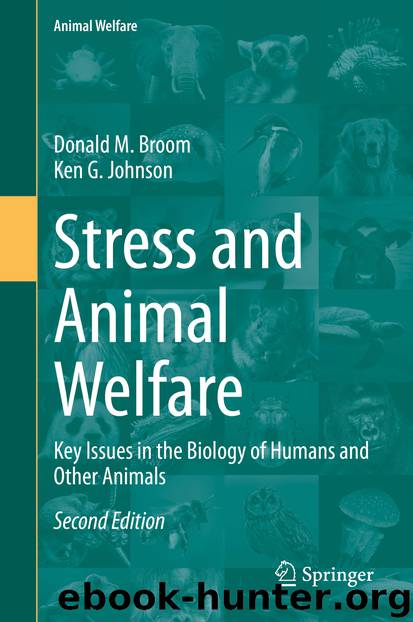Stress and Animal Welfare by Donald M. Broom & Ken G. Johnson

Author:Donald M. Broom & Ken G. Johnson
Language: eng
Format: epub
ISBN: 9783030321536
Publisher: Springer International Publishing
Cortisol (n mol l−1)
Control
87
Tail dock
136
Castration
171
Mulesing and tail dock
187
Mulesing, tail dock and castration
232
Further evidence for links between adrenal cortex response and pain comes from the findings that analgesia can substantially reduce the response, for example in new-born human infants undergoing surgery (Anand et al. 1987, 1988). Such results led to a general move to use analgesics after minor operations on new-born babies. Most people are amazed to learn that human babies up to 6 or 12 months were routinely operated upon without the use of analgesics until the 1970s–1990s, the date of change depending on country. In future there may be the same amazement that in 2019 many operations on sentient farm animals are conducted without analgesic use. Links between predictably painful situations, adrenal cortex response and suppression of this response by a proven analgesic are particularly useful in the assessment of pain (Stilwell et al. 2009). There can be adrenal cortex responses associated with tissue damage during farm operations even when an anaesthetic was used (Petrie et al. 1996). It may be that, although pain was prevented by the anaesthetic, the cortisol increase is a consequence of other poor welfare (Stilwell et al. 2012). Alternatively, the damage itself, even if not perceived, may cause an adrenal response . Cortisol is produced by epidermal cells when there is local tissue damage (Vukelic et al. 2011).
Various forms of laboratory animal handling , for management or experimental purposes, elicit adrenal cortex responses. Kvetnansky et al. (1978) found that handling for 30 s doubled plasma glucocorticoid levels in rats and significant increases also occurred in rats when their cages were moved from a rack to the floor or a table (Gärtner et al. 1980). Zebrafish Danio rerio, the commonest laboratory vertebrate, more than doubled their plasma cortisol concentration 3 min after being caught in a net (Ramsay et al. 2009). After 15 min the cortisol concentration was six times the basal level and, as is normal with cortisol, the concentration declined to basal level by 1 h after the handling. Mice and rats show elevated plasma corticosterone levels when put into a novel environment and the extent of corticosterone elevation is related to the degree of novelty , as shown in Fig. 5.1 (Hennessy and Levine 1978). Similarly, children with autism had increased plasma cortisol after exposure to novel stimuli (Spratt et al. 2012).
Fig. 5.1Plasma corticosterone in mice in their home cage, and shortly after exposure to novel situations with different degrees of difference from the home cage (modified after Hennessy and Levine 1978)
Download
This site does not store any files on its server. We only index and link to content provided by other sites. Please contact the content providers to delete copyright contents if any and email us, we'll remove relevant links or contents immediately.
| Amphibians | Animal Behavior & Communication |
| Animal Psychology | Ichthyology |
| Invertebrates | Mammals |
| Ornithology | Primatology |
| Reptiles |
Sapiens: A Brief History of Humankind by Yuval Noah Harari(14311)
The Tidewater Tales by John Barth(12625)
Mastermind: How to Think Like Sherlock Holmes by Maria Konnikova(7274)
Do No Harm Stories of Life, Death and Brain Surgery by Henry Marsh(6904)
The Thirst by Nesbo Jo(6877)
Why We Sleep: Unlocking the Power of Sleep and Dreams by Matthew Walker(6651)
Life 3.0: Being Human in the Age of Artificial Intelligence by Tegmark Max(5506)
Sapiens by Yuval Noah Harari(5321)
The Longevity Diet by Valter Longo(5039)
The Body: A Guide for Occupants by Bill Bryson(5026)
The Rules Do Not Apply by Ariel Levy(4907)
The Immortal Life of Henrietta Lacks by Rebecca Skloot(4547)
Animal Frequency by Melissa Alvarez(4424)
Why We Sleep by Matthew Walker(4394)
The Hacking of the American Mind by Robert H. Lustig(4336)
Yoga Anatomy by Kaminoff Leslie(4331)
All Creatures Great and Small by James Herriot(4267)
Double Down (Diary of a Wimpy Kid Book 11) by Jeff Kinney(4239)
Embedded Programming with Modern C++ Cookbook by Igor Viarheichyk(4137)
